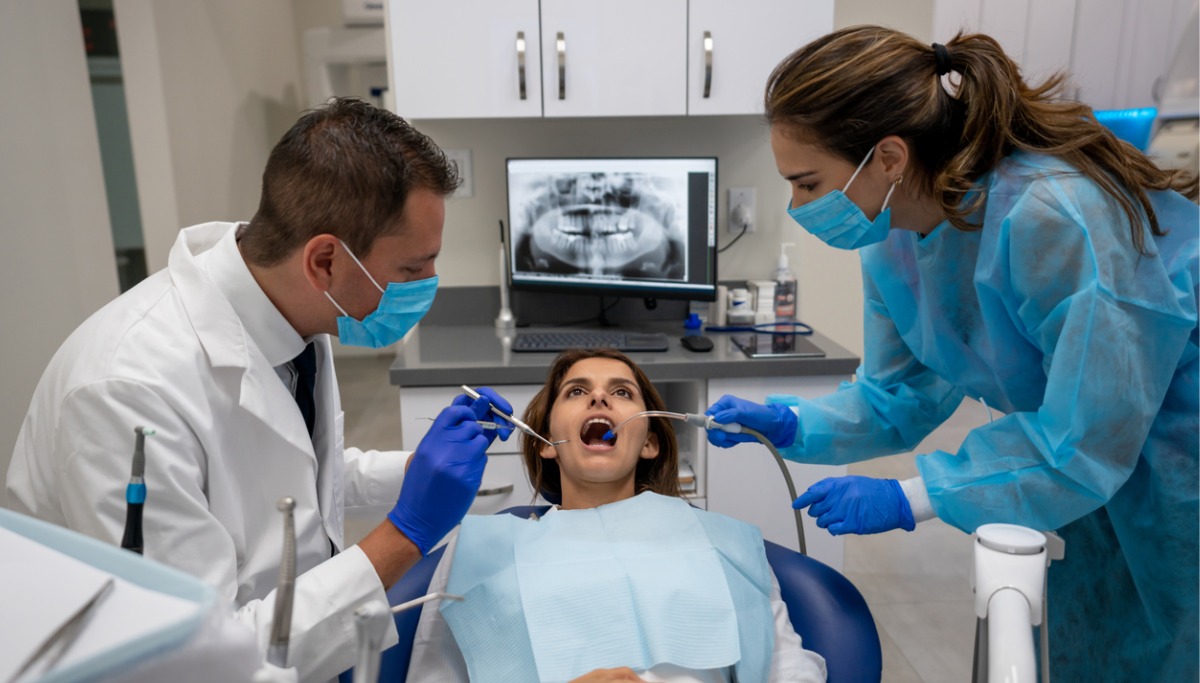What is a dry socket?
Alveolar osteitis, or better known as dry socket, is one of the more common complications that can occur after a dental extraction. It most often affects impacted lower third molar extraction sites but can occur after any extraction. For reasons not fully understood, the protective blood clot that normally forms right after the surgery in the extraction site either never forms or breaks down soon after it has formed. This leaves the bone in the tooth socket exposed, resulting in moderate to severe pain at the extraction site. A dry socket is characterized by a sudden increase in pain intensity a few (one to five) days after the extraction.
Dry socket signs and symptoms
It is important to watch out for the signs and symptoms of a dry socket post-surgery.
Signs and symptoms can include:
- An increase in pain severity a few days after a tooth extraction.
- Partial or total loss of the blood clot at the tooth extraction site that you may notice as an empty-looking (dry) socket.
- Visible bone in the socket.
- Pain may radiate from the socket to your ear, eye, temple, or neck on the same side of your face as the extraction.
- Slight fever
- Bad breath, or a foul smell or taste in your mouth.
If you are concerned with any unusual symptoms after an extraction, such as a sudden increase in pain, a fever, or swelling, make sure to let your dentist or oral surgeon know. They will work with you to determine the best course of treatment.
How do you treat a dry socket?
In most cases, a dry socket will heal itself after about a week, but it can cause ongoing moderate to severe pain. Your dentist can take steps to help ease the discomfort while the socket heals.
To ease pain and discomfort, your dentist may do one or more of the following:
- Rinse the site with salt water and instruct you how to do it at home.
- Place a medicated gauze inside the socket to provide relief. This gauze may need to be replaced every day or two until pain symptoms resolve.
- Provide instructions on how to properly ice the surgical site.
- Instruct you to take over-the-counter medications or prescribe pain medication.
- A dry socket is not an infection, so antibiotics are not usually prescribed. If your dentist suspects an infection is developing, antibiotics may be prescribed .
What are the risk factors for dry sockets?
Factors that can increase your risk of developing dry socket include:
- Smoking and tobacco use – The chemicals in cigarettes or other forms of tobacco may prevent healing and contaminate the wound site. Also, the physical act of sucking on a cigarette may prematurely dislodge the blood clot.
- Improper at home care – Post-surgery, your surgeon should give you instructions on how to take care of your extraction site at home. Failure to follow those guidelines can increase the risk of a dry socket forming.
- Poor oral hygiene – Improper care of your teeth will increase the risk of a dry socket
- Oral contraceptives - Females taking contraceptives may be at increased risk.
- Tooth or gum infection – Current or previous infections around the extracted tooth increase the risk of dry socket.
- Difficult extractions – The most common cause of dry socket of a difficult extraction is impacted lower third molars (wisdom teeth).
- Having a past dry socket – If you've had a dry socket in the past, you're more likely to develop it after another extraction.
How long does a dry socket last?
Dry sockets usually last up to one week.
How to prevent dry sockets?
Despite the best efforts of the surgeon and patient, dry sockets can occur. However, there are steps you can take to limit the risk.
To help prevent a dry socket and aid your recovery after a tooth is extracted:
- Carefully follow all pre-surgery and post-surgery instructions from your oral surgeon.
- Don’t drink through a straw for the first 24 to 48 hours as the sucking action could disturb the blood clot in the socket.
- Avoid smoking for several days before and after your extraction.
- Gently brush your other teeth twice a day, pay special attention to the gum line, and floss at least once daily. Try to avoid the area around the tooth socket for the first couple of days.
- If you rinse out your mouth, do so gently. Don’t overdo rinsing, or you may dislodge the blood clot in the socket that helps speed healing.
- Avoid warm and carbonated beverages.
- Avoid crunchy, hard, and chewy foods.
Sources:
1. Dry Socket. (2022, March 28) from https://my.clevelandclinic.org/health/diseases/17731-dry-socket
2. An Overview of Dry Socket. (2022, April 2) from https://www.webmd.com/oral-health/guide/dry-socket-symptoms-and-treatment







